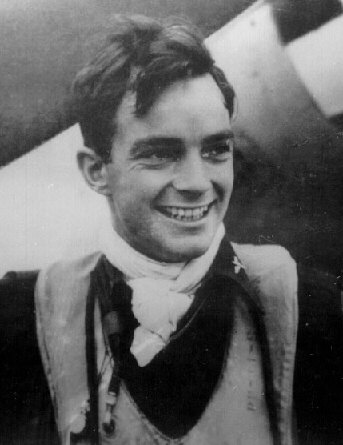

Education: Englewood, NJ, School for Boys, class of 1940, attended Princeton University, Pratt Institute, Certificate in Industrial Design.
Military Career: United States Army Air Corps during World War II, flying 68 missions over Europe, logging 273 combat flying hours. In the Korean War, he flew F-84 E, F, and G modifications. 1955-1957: Worked on classified assignments. He was one of the original six U-2 aircraft pilots - the first to fly a spy mission in a U-2 over Russia. Vietnamese War: Commander of the 366th Tactical Fighter Squadron, flew F-4C missions, Da Nang Air Base, South Vietnam. POW: June 11, 1967 - March 4, 1973. Staff Officer at NATO, attended the War College, serving as President (Class of '74), and then joined the Air Force Test and Evaluation Center as the first Director of Joint Test and Evaluation.
As a Command Pilot with 5,600 flying hours that included 378 combat missions in three wars, his military decorations include the Silver Star; the Legion of Merit; the Distinguished Flying Cross with OLC; a Meritorious Service Medal; the Air Medal with 11 oak-leaf clusters; and the Purple Heart.
You'll have to go some to find a better man than this.
When Major Stockman arrived at the 482nd, the buzz was that he had flown U-2s. But it was hush-hush and really only whispered about. What we didn't know was that he was one of the original six U-2 pilots and had flown the first mission over Russia from Wiesbaden, Germany, on July 4, 1956, as a civilian working for the CIA. Stockman's flight was expected to be radar impervious, but was detected by Soviet radar and intercepted by MIG fighters along the Minsk to Leningrad leg, however, the U-2 was 20,000 feet above the MIG's ceiling and was untouchable, at that point in time.
The next day, the same U-2 was flown all the way to Moscow, piloted by Carmine Vito. Again, the flight was detected and interceptors were launched. On July 10, 1956, the Soviet Union sent a protest note to Washington, detailing the first two flights and mentioning two more which took place on July 9th.
I remember a flight of Major Stockman's at Oceana Naval Air Station. He had required extra fuel so the reserve wing tanks were loaded. Everything went well until we got a call that there might be a problem so everyone hustled out to meet the plane. The right side tank had collapsed with about a 75 degree bend, as the fuel was sucked out, the air relief valve had malfunctioned and air pressure had compressed the tank like tissue paper. Luckily, it bent to one side...had it collapsed upward it could have damaged the wing enough that a real problem could have developed. I looked up at Major Stockman and he was calmly writing on his pilot's pad as though nothing was amiss. When he finally deplaned and took a good look at the tank, I think he worked up enough enthusiasm to say something like, "How about that?" After flying a U-2 over Russia, what was a bent tank to get excited over.
Lt. Col. Stockman was an Andover, New Jersey native, and prior to joining the US Army Air Corps during WW II, had attended Princeton University for two years, studying architecture. He trained in Texas and received his commission and wings in the summer of 1943. He was assigned to the 339th Fighter Group, 504th FS in England where he logged 68 missions as a P-51 fighter pilot...the name of his plane was the "Fuxum." After the war, he attended the Pratt Institute Art School In New York City, majoring in Industrial Design, and became an automobile designer for General Motors at Detroit.
We might have all been driving cars with wings except that the Korean war caused Mr. Stockman to be recalled to active duty in 1951. I don't know his exact history here but at some point prior to 1956, he was a CIA civilian, on paper at least. Apparently, the 482nd was his first squadron assignment after U-2s and rejoining the Air Force. He also had assignments prior to Vietnam with the Armed Forces Staff College and NATO. In December of 1966, Lt. Col. Stockman was in Vietnam as Squadron Commander of the 366th TFW, 390 TFS at Da Nang. Along with Ronald Webb, who also survived the same fate, Lt. Col. Stockman's F-4C was shot down on June 11, 1967.
Lt. Col. Stockman was to face nearly six years (2,093 days) in the various POW prisons of Hanoi (Heartbreak, Las Vegas, Plantation, and Unity), living in a seven by seven foot cell. He was reluctant to speak of this trial and ordeal but made an exception for a class of students, saying that, "Preparing these words was much like visiting an old, untended graveyard." He went on to say his treatment was brutal and that when he emerged from captivity that he "was a foul, decrepit wreck of a man." The process of recovery was slow, painful, deliberate, and gradually "my mind was awakened and reunited to my body and I had the will to live and regain my strength."
After Vietnam, Lt. Col. Stockman remained in the service for a time, serving with NATO and at the Air War College in Alabama. He retired as a gentleman officer, along with his wife, Sally, to Albuquerque, New Mexico, where he still lives as an American hero, exercising an active interest in philantropy.
Well done, sir...damn well done. We of the 482nd are proud to have served with you.
PHOTO: Circa 1944/45 as 1st Lt.
This page is located at
http://www.pinetreeline.org/metz/otherm9w.html
Updated: September 23, 2003